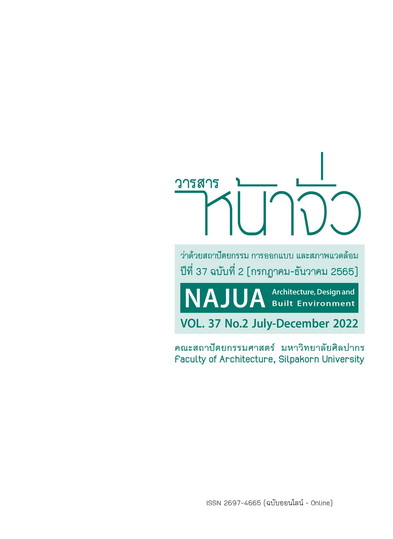ความเป็นมาเกี่ยวกับปัญหาเกลืออีสานที่บดบังความเป็นมรดกทางวัฒนธรรม
คำสำคัญ:
เกลืออีสาน, มรดกทางวัฒนธรรม, สิ่งแวดล้อมสรรค์สร้าง, สถาปัตยกรรมพื้นถิ่นบทคัดย่อ
งานศึกษาที่ผ่านมา เรื่องของเกลืออีสานมักเกี่ยวกับประเด็นที่ต้องแก้ไขเพื่อส่งเสริมพืชเศรษฐกิจเสียมากกว่าเรื่องราวคุณค่า ความเป็นมาและความเป็นมรดกทางวัฒนธรรมที่เป็นรูปธรรมและเป็นนามธรรม รูปแบบของภูมิทัศน์พื้นที่การผลิตที่สัมพันธ์กับการตั้งถิ่นฐาน พิธีกรรม ความเชื่อ เรื่องเล่า และวัฒนธรรมอาหารที่สืบเนื่องเป็นเวลากว่าพันปีจากงานศึกษาทางโบราณคดี มานุษยวิทยา แต่กระนั้นภาพจำเรื่องเกลืออีสานมีสภาพเป็นปัญหาที่บดบังความรู้ความเข้าใจ และโอกาสต่อยอดภูมิปัญญาดังกล่าว
บทความนี้ต้องการฉายภาพให้เห็นลำดับเรื่องราวของงานศึกษาและประเด็นทางวิชาการสำคัญเกี่ยวกับเกลืออีสาน รวมถึงสรุปประเด็น และเครื่องมือการศึกษาต่าง ๆ เพื่อให้เห็นภาพในส่วนต่าง ๆ เรียงร้อยเข้าด้วยกันเปิดเผยมุมมองต่อเกลืออีสานในหลากมิติ เพื่อสลายมายาคติดินเค็ม และก้าวข้ามไปสู่การเป็นแหล่งเรียนรู้ และมรดกทางวัฒนธรรมของชุมชนด้านธรณีวิทยา อีกทั้งเกิดประโยชน์ทางวิชาการแก่หน่วยงานที่เกี่ยวข้องในการนำไปต่อยอดต่อไป
เอกสารอ้างอิง
Aengwanich. W., (2003). Wattatam Pla Lum Maenam Chi. (In Thai) Mahasarakham University.
Department of Mineral Resources. (1998). Geology of Thailand. Bangkok: Department of Mineral Resources Ministry of Natural Resources and Environment Thailand.
Horayangkura. V., (1993). Satanapap pon khan wichakarn Saka Sathapattakam Nai Pratet Thai. (In Thai) [The status of Academic Outputs in Architecture in Thailand]. Bangkok: National research council of Thailand.
Hiam, C., and Thosrat, R., (1999). Siam Dukdambun Yook kornpravatsatra tung samai Sukhothai. (In Thai) [Siam prehistory to Sukhothai period]. Bangkok: River book.
Hengrajamee, T., and the others. (1992). Architectural Development for Housing in Rural Isan. Khonkaen: Faculty of Architecture, Khonkaen University.
Herring. A., (2010). Tobacco & Salt Museum. (English edition). Japan: Hikari Shasin Printing Center, Ltd.,
Inpuntung, V., (2004). Sathapattakam Nai WattanaTham Koa. (In Thai) [Vernacular Architecture in Rice culture]. Bangkok: Faculty of Architecture, Silpakorn University.
Kunurat, P. (1981). Phoomi Sarta Isan. (In Thai) [Geography of northeast of Thailand]. Khonkaen: Khonkaen University.
Muadthong. A., (2016). “Toponym and Its Definition through Pha Dang Nang Ai Tale: A case study of communities around NongHarn Lake, UdonThani Province”. in proceedings Vernacular Architecture and Cultural Environment. Khonkaen: Faculty of Architecture, Khonkaen University. pp. 169-177.
Muadthong. A., (2018). Sing Wad Lom San Sang Puein Tin Nai Wattatam Klur Esan. (In Thai) [Vernacular Built Environment in Isan Salt Culture] Doctor of Philosophy (Vernacular Architecture) Department of Architecture, Silpakorn University.
Masuhara. Y., (2012). Prawat Sat Settakit Kong Racha Anajak Lanchang. (In Thai) Bangkok: Mathichon.
Oliver. P., (1997). Encyclopedia of Vernacular Architecture of the world. Cambridge: Cambridge University Press.
Panin. O., (2002). Pramern Satanapap Thai suk sa saka Sathapattakam Silpakam lae Huttakam. (In Thai) [The Evaluation of the status of Thai studies in Architecture, Art, and Crafts]. Bangkok: Faculty of Architecture, Silpakorn University.
Panin. O., (2006). Kan anurak lae pattana thongthin yang yung yuen. (In Thai) [Sustainable Local Heritage Conservation: The Transdisciplinary Approach]. (Eds.) Proceeding of International Conference: Sustainable Local Heritage Conservation: The Trandisciplinary Approach and ICOMOS Thailand Annual Meeting 2006.
Pimonsatien. Y., (2005). Si Sip Pee lung Venice charter. (In Thai) [40th years after Venice charter]. Rattanachaiyanon, Russamee.(Eds.) Proceedings Scientific Seminar on 2Decade of ICOMOS.
Rapoport. A., (1990). The meaning of the Built environment a nonverbal communication approach. The University of Arizona Press.
Suwanich. P., (2009). Toranee land rae Potash-klur hin khong thai. (In Thai) [Geology in Mineral source Potashand rock salt in Thailand]. Bangkok: campeewan co.ltd.
Suthitham. T., (2001). Pung muang nai Prates thai Pung chumchon lae karn shai teedin sai Arayathama kmer nai pak tawa nook chiengnur. (In Thai) [ Planning and land used in Kamer civilization in northeastern of Thailand]. Khonkaen: Pimpattana.
Theerasawat. S., (2014). Prawattisat Isan 2322 - 2488. (In Thai) [Isan History] 1st Editon. Khonkaen: Khonkaen University.
Topark-ngarm. B., (2006). Din kem pak tawa nook chiengnur. (In Thai) [Saline Soils in Northeast Thailand]. Khonkaen: Khonkaen University.
Vallibhothama. S., (2003). Tung kula Anajak klur 2500 pee. (In Thai). [Tung kula Salt] Empire 2500 Years]. Bangkok: Mathichon.
Satarugsa. P., (2005). Toranee wittaya krongsang. (In Thai) [Structural Geology] Khonkaen: Khonkaen University.
W.J.van Liere., (1982). Klur kap karn tung tin tan nai Prates thai. (In Thai) [Salt and Settlement in Northeast Thailand]. Muang Boran 8(2), pp.112-118.
ดาวน์โหลด
เผยแพร่แล้ว
รูปแบบการอ้างอิง
ฉบับ
ประเภทบทความ
สัญญาอนุญาต

อนุญาตภายใต้เงื่อนไข Creative Commons Attribution-NonCommercial-NoDerivatives 4.0 International License.





